Bryan L. Programmable controllers. Theory and implementation
Подождите немного. Документ загружается.


PROCESS CONTROLLERS
AND LOOP TUNING
CHAPTER
FIFTEEN
Confusion worse confounded.
—John Milton
Industrial Text & Video Company 1-800-752-8398
www.industrialtext.com

670
SECTION
4
PLC Process
Applications
Industrial Text & Video Company 1-800-752-8398
www.industrialtext.com
CHAPTER
15
Process Controllers
and Loop Tuning
CHAPTER
HIGHLIGHTS
In the previous chapter, we explained some important topics, such as
process variable responses and transfer functions, that are elemental to the
understanding of process control. In this chapter, we will continue our
discussion of process control by explaining how a controller regulates a
process. We will discuss the different types of controllers available, their
advantages and disadvantages, and the effects that they have on the processes
being controlled. We will also examine several tuning methods that are
used to stabilize the process and determine the controller’s tuning constants.
After you finish this chapter, you will be ready to integrate PID control into
a PLC application.
15-1 INTRODUCTION
The behavior of a closed-loop control system depends not only on the
characteristics of the process and its transfer function, but also on the type of
controller and the design decisions that occur during the selection of tuning
parameters. As we explained previously, in a process control system, the
process receives control information from the controller in the form of the
control variable, which acts on the control element or process actuator (e.g.,
valve). The normal value of the control variable is usually at 50% of its
range, so that it can either increase or decrease to accommodate for changes
in the process variable.
The effect that a controller has on the process is the result of its action, or
operational mode. Like the process itself, a controller also has a transfer
function, which can be represented mathematically by Laplace transforms.
The interaction between the controller and the process comprises the true
essence of closed-loop process control.
In process control, the controller is responsible for the stability of the control
system. Figure 15-1 illustrates three types of stability responses:
• stable
• conditionally stable
• unstable
Stable responses have an asymptotic characteristic, meaning that, as time
increases, the response of the system approaches some finite value (see
Figure 15-1a). Conversely, conditionally stable responses have a sinusoidal-
type wave shape (see Figure 15-1b). This sinusoidal response has a low
amplitude and may be acceptable in noncritical control loops, but not in the
control of critical processes. Unstable responses, as the name implies, are
system responses that are not acceptable because they create an unstable, or
“runaway,” condition (see Figure 15-1c). The sinusoidal amplitude of an
unstable response increases as time increases.
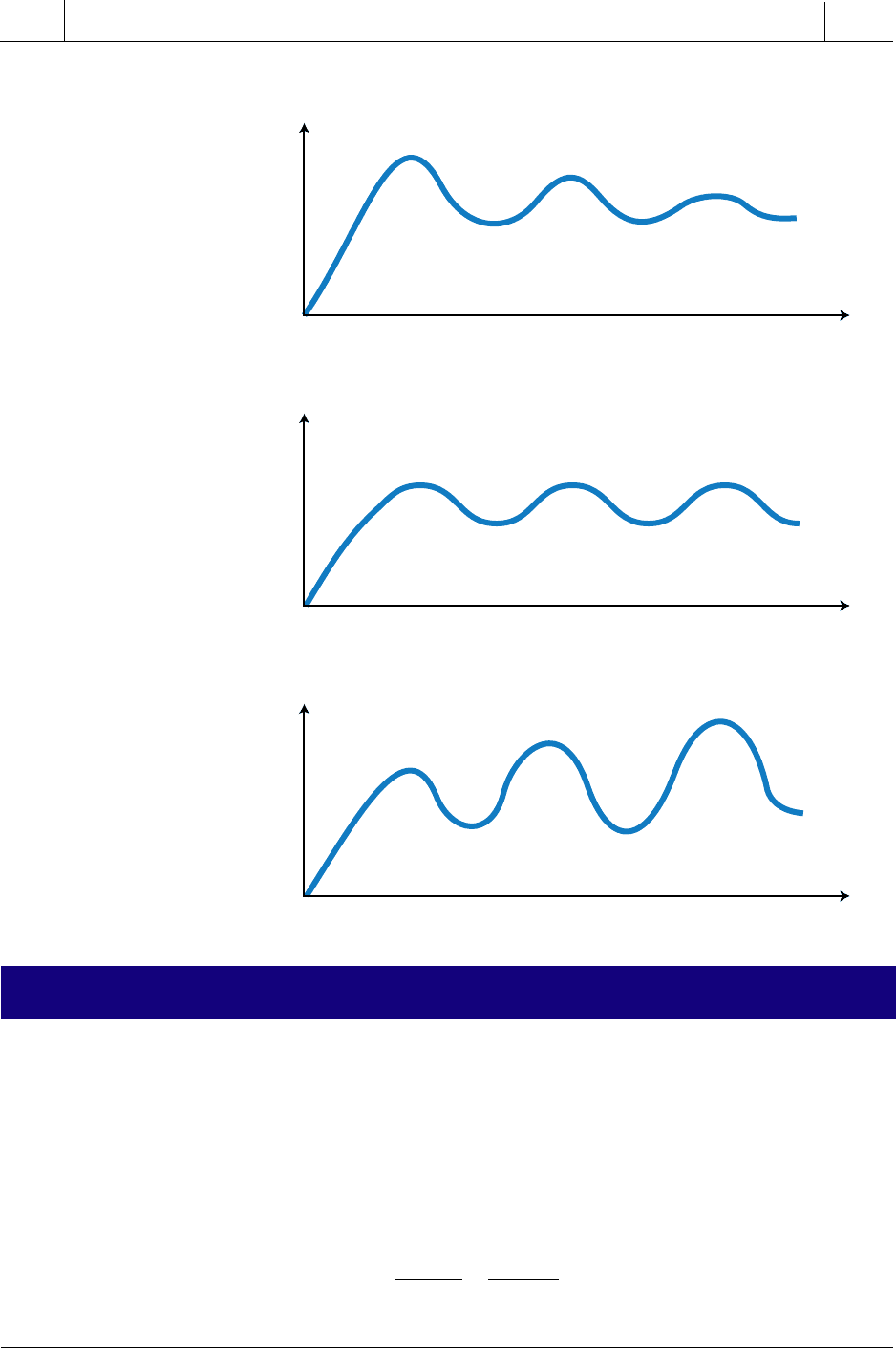
671
CHAPTER
15
Process Controllers
and Loop Tuning
SECTION
4
PLC Process
Applications
Industrial Text & Video Company 1-800-752-8398
www.industrialtext.com
PV
Response
t
PV
Response
t
PV
Response
t
(a)
(b)
(c)
Figure 15-1. (a) Stable, (b) conditionally stable, and (c) unstable responses.
15-2 CONTROLLER ACTIONS
In the previous chapter, we explained how a process’s transfer function
indicates the process’s behavioral response to an input change. Now, we will
explain the controller’s transfer function, Hc, along with the types of control-
ler modes used to control the process. Figure 15-2 illustrates an open-loop
configuration of the controller and process transfer functions by themselves,
in which the controller’s output (the control variable CV) is the input to the
process. The transfer function for this open-loop configuration is:
Output
Input Input
==
()()
PV
Hc Hp
s
s
ss
()
()
() ()
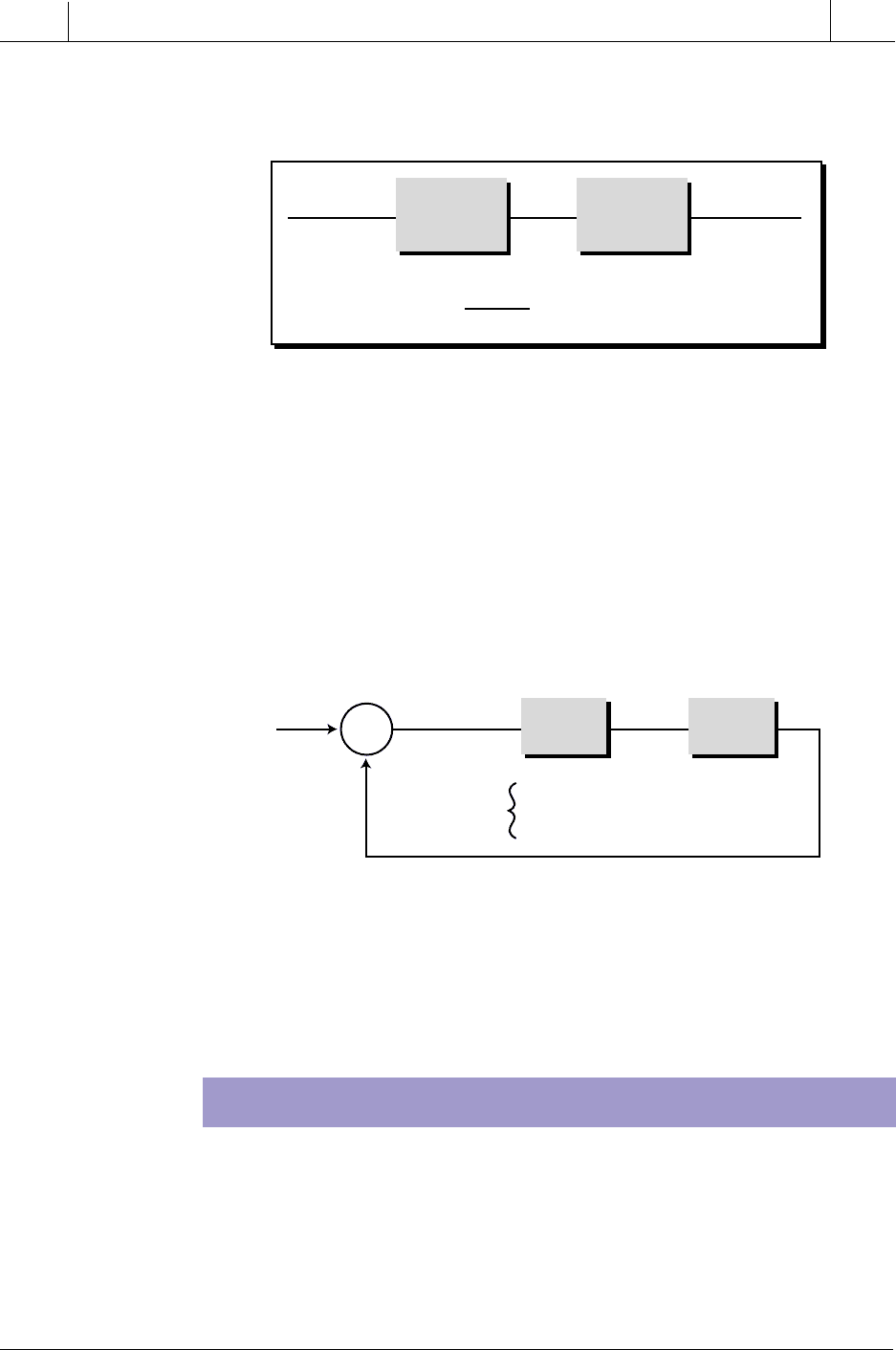
672
SECTION
4
PLC Process
Applications
Industrial Text & Video Company 1-800-752-8398
www.industrialtext.com
CHAPTER
15
Process Controllers
and Loop Tuning
where Hc
(s)
and Hp
(s)
are the controller and process transfer functions in
Laplace form.
Figure 15-2. Open-loop system configuration.
As in an open-loop system, the controller in a closed-loop system also
regulates the process variable value. However, a closed-loop controller
provides either a direct action or a reverse action to the process it is
controlling (see Figure 15-3). The difference between these two types of
actions is the effect that the control variable (CV) from the controller (Hc) has
on the process variable (PV) of the process (Hp). The type of process behavior
required by an application determines the type of controller action needed in
the system. For instance, a heating system and a cooling system behave
differently, so their controller actions must behave differently as well.
Figure 15-3. Closed-loop system configuration.
Note that, in a closed-loop control system, the key variable input to the
controller is the error signal. After interpreting the error signal, the controller
sends commands to the process via the control variable to bring the error to
zero. In this chapter, we will refer to the error signal as the input to the
controller and to the control variable as the controller output.
PVCV
Hp
(Process)
Hc
(Controller)
Input Output
= (
Hc
(s)
)(
Hp
(s)
)
PV
(s)
Input
(s)
HpHc
Hc
E
=
SP
–
PV CV PVSP
+
–
Direct-Acting
or
Reverse-Acting
Σ
DIRECT-ACTING CONTROLLERS
A direct-acting controller is a closed-loop controller whose control
variable output increases in response to an increase in the process variable.
This is the type of action exhibited by a typical air-cooling system. As the
temperature (PV) increases (i.e., it becomes warmer), the controller increases
the value of its output (i.e., it increases the output of the air-conditioning
compressor) to bring the process variable back to the set point.
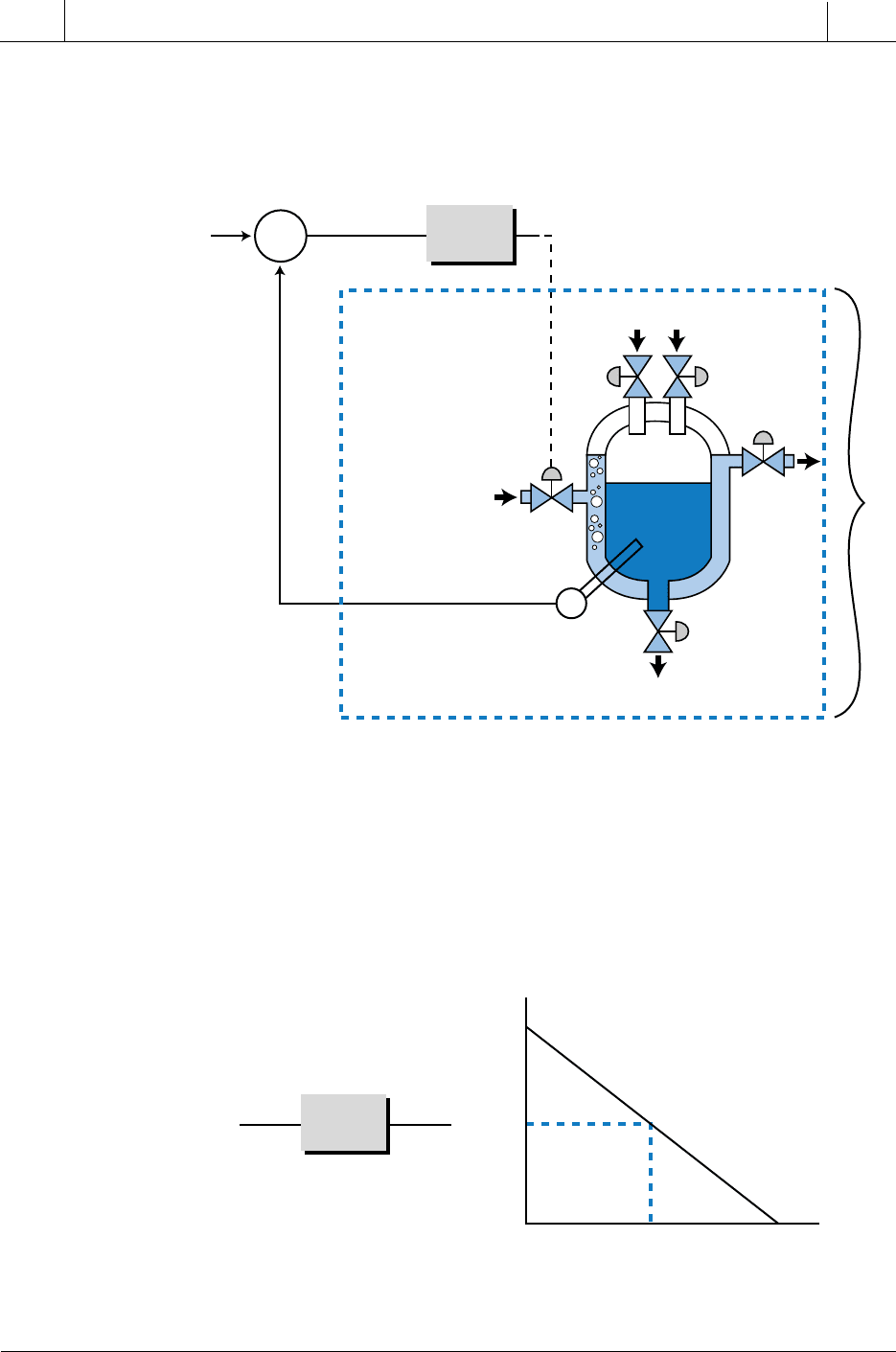
673
CHAPTER
15
Process Controllers
and Loop Tuning
SECTION
4
PLC Process
Applications
Industrial Text & Video Company 1-800-752-8398
www.industrialtext.com
Figure 15-4 illustrates another example of a direct-acting controller in which
two materials are mixed in an exothermic (heat-producing) batch. Cold water
flowing through the tank jacket cools the batch. A temperature sensor
measures the temperature process variable, which has a cool set point.
Figure 15-4. Direct-acting controller controlling the temperature in a batch-cooling process.
Figure 15-5 shows the reaction of the process in Figure 15-4. If the control
variable that controls the cold water valve is open 100% (full open), the
temperature of the batch will be 100°F; if the cold water valve is at 0%
(closed), the temperature of the batch will be at 200°F. The desired set point
of this process is 150°F, which corresponds to a 50% controller output.
Therefore, in this process, if the cold water control valve opening increases,
the system temperature decreases and vice versa.
Figure 15-5. Process variable’s reaction to a direct-acting controller.
Hc
E = SP – PV CV
PV
SP
+
–
Σ
Cold
Water
In
Temperature
Sensor
Product Discharge
Water
Out
Material 1 Material 2
Hp
Hp
CV PV
0%
50%
100%
100°F
SP
= 150°F 200°F
CV
PV
If
CV
increases,
PV
decreases in the process
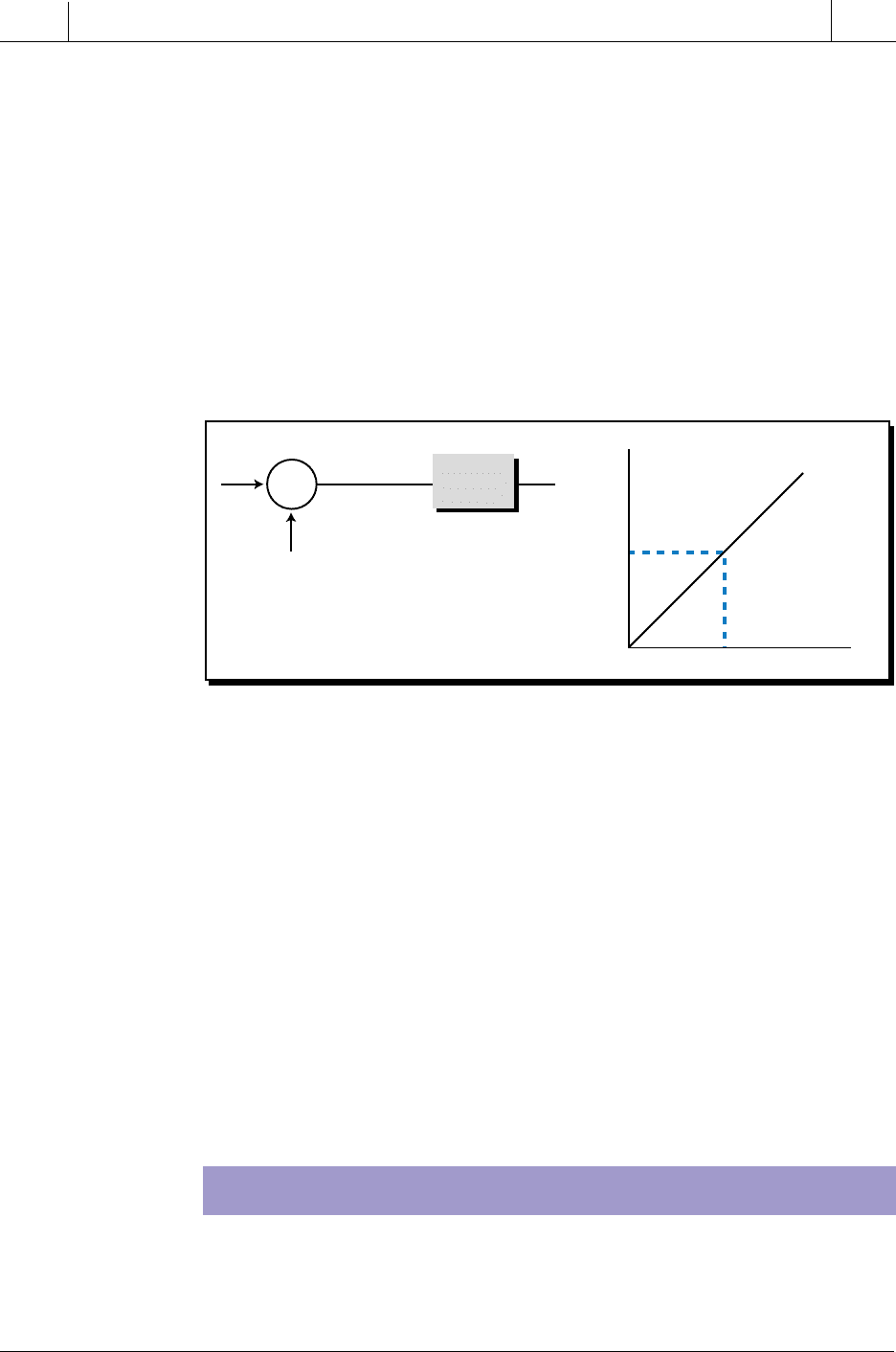
674
SECTION
4
PLC Process
Applications
Industrial Text & Video Company 1-800-752-8398
www.industrialtext.com
CHAPTER
15
Process Controllers
and Loop Tuning
Figure 15-6 shows the reaction of the controller to the process variable. If the
controller senses that the temperature is too hot, it opens the cold water valve
more to cool off the batch. Conversely, if the temperature is too cold, the
controller decreases the opening of the control valve to warm up the tempera-
ture. Therefore, the controller in this system is a direct-acting controller
because, as the process variable (temperature) increases, the controller
increases its control variable output (opens the valve for more cold water) to
bring PV closer to the set point, thus bringing the error to zero. In terms of
error, the equation E = SP – PV indicates that a direct-acting controller will
increase its output as the error value in the system becomes more negative (as
PV increases, E becomes more negative) and will decrease it as the error
becomes more positive (as PV decreases, E becomes more positive).
Figure 15-6. Relationship between
CV
and
PV
in a direct-acting controller.
In process control applications, a direct-acting controller is sometimes said
to respond to a positive increase in error with an increase in the control
variable (increase in controller output). The term “positive error,” however,
can be deceiving because it refers to the error change in the process variable,
not to the change in the actual system error value. For example, referring to
Figure 15-6, if the temperature (PV) increases from the set point of 150°F to
160°F, the direct-acting controller will increase the control variable because
the process variable has increased by +10°F. This change in the process
variable is a positive error because the actual PV value has changed in a
positive direction. The system error (E), on the other hand, will become more
negative due to this same change. When PV equaled the set point, the system
error was 0 (150°F – 150°F). When the process variable increased to 160°F,
however, the system error became –10°F (150°F – 160°F). Regardless of the
terminology used, a direct-acting controller senses the direction of change in
both the process variable and error and responds appropriately.
REVERSE-ACTING CONTROLLERS
A reverse-acting controller behaves oppositely of a direct-acting con-
troller—if the controller detects an increase in the process variable, it will
respond by decreasing the control variable. This behavior is typical of a
Hc
E = SP – PV CV
PV
SP
+
–
Σ
0%
50%
100%
100°F 150°F 200°F
CV
P
V
• If the temperature (
PV
) is 160°F,
the controller must
increase
CV
• If the temperature (
PV
) is 140°F,
the controller must
decrease CV

675
CHAPTER
15
Process Controllers
and Loop Tuning
SECTION
4
PLC Process
Applications
Industrial Text & Video Company 1-800-752-8398
www.industrialtext.com
Figure 15-7. Reverse-acting controller controlling the temperature in a batch-heating
process.
heating system. As the temperature becomes warmer (PV increases), the
controller decreases the amount of heat the furnace produces to maintain the
temperature at the set point.
Figure 15-7 illustrates a heating process in which a steam control valve
allows heat to enter into the tank jacket of the batch system. The graph
illustrated in Figure 15-8 shows that, in this heating system, if the steam
control valve (CV) is at 100%, the temperature (PV) of the batch will be 200°F.
Conversely, if the steam valve is at 0%, or completely closed, the batch
temperature will drop to 100°F. To maintain the set point at 150°F, the
controller must maintain the control variable output at 50% of its range.
Figure 15-9 shows the relationship between the control variable and the
process variable for the controller in this system. Because it is a reverse-acting
controller, if the process variable (temperature) increases, the controller
decreases its output to bring the error closer to zero.
Hc
E = SP – PV CV
PV
SP
+
–
Σ
Steam
In
Temperature
Sensor
Product Discharge
Water
Out
Material 2Material 1
Hp
The selection of a direct- or reverse-acting controller depends on the behavior
of the process itself. If the process reacts in a direct manner (PV increases as
CV increases), the system’s controller must provide reverse action, as in the
case of a heating system, to control the process. If the process reacts in an
inverse manner (PV increases as CV decreases), the controller must use direct
action to control the process. Some single-loop controllers have a toggle
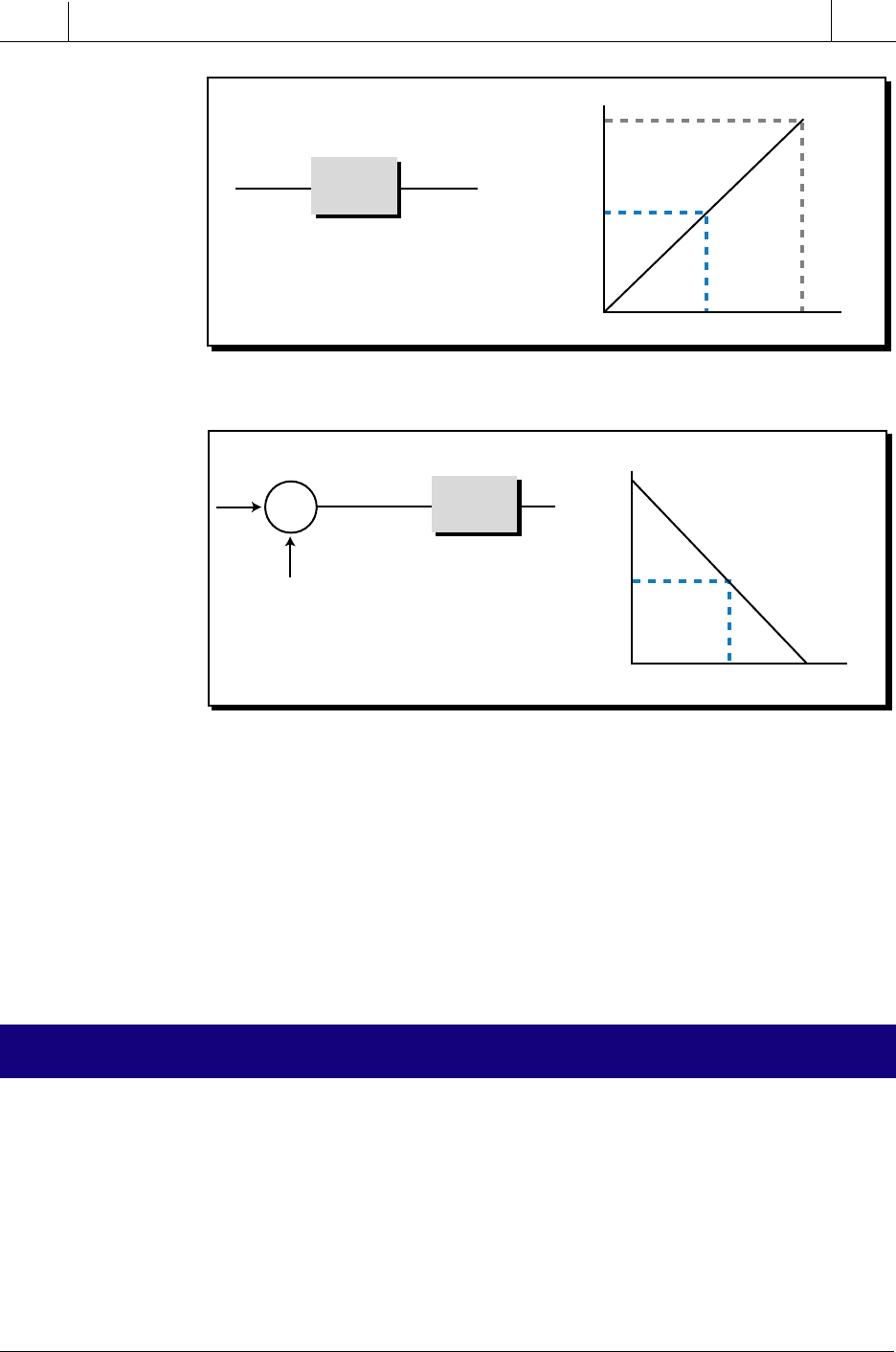
676
SECTION
4
PLC Process
Applications
Industrial Text & Video Company 1-800-752-8398
www.industrialtext.com
CHAPTER
15
Process Controllers
and Loop Tuning
switch that can be used to select the desired action of the controller (direct or
reverse). The control switch on a home thermostat is an example of this type
of switch. During the winter, when the switch is set to heat, the system
operates in a reverse-acting mode. During the summer, when the switch is set
to cool, the system operates in a direct-acting mode. The closed-loop system
remains the same, except for the behavior of the controller. The process
behavior, which changes from winter to summer, necessitates the switch
from reverse to direct action.
Figure 15-8. Process variable’s reaction in a reverse-acting controller.
Figure 15-9. Relationship between
CV
and
PV
in a reverse-acting controller.
15-3 DISCRETE-MODE CONTROLLERS
A controller can have one of two modes that describes its output signal:
• discrete (ON/OFF) mode
• continuous (analog) mode
In discrete mode, the controller produces a discontinuous ON/OFF signal as
its output (the control variable), which serves as the input to the process (see
Figure 15-10a). In continuous mode, the controller emits an analog output
Hp
PVCV
0%
50%
100%
100°F
SP
= 150°F 200°F
CV
PV
If
CV
increases,
PV
increases
Hc
E = SP – PV CVSP
+
–
Σ
0%
50%
100%
100°F
SP
= 150°F 200°F
CV
PV
• If the temperature (
PV
) is 160°F,
the controller must
decrease
CV
• If the temperature (
PV
) is 140°F,
the controller must
increase
CV
PV
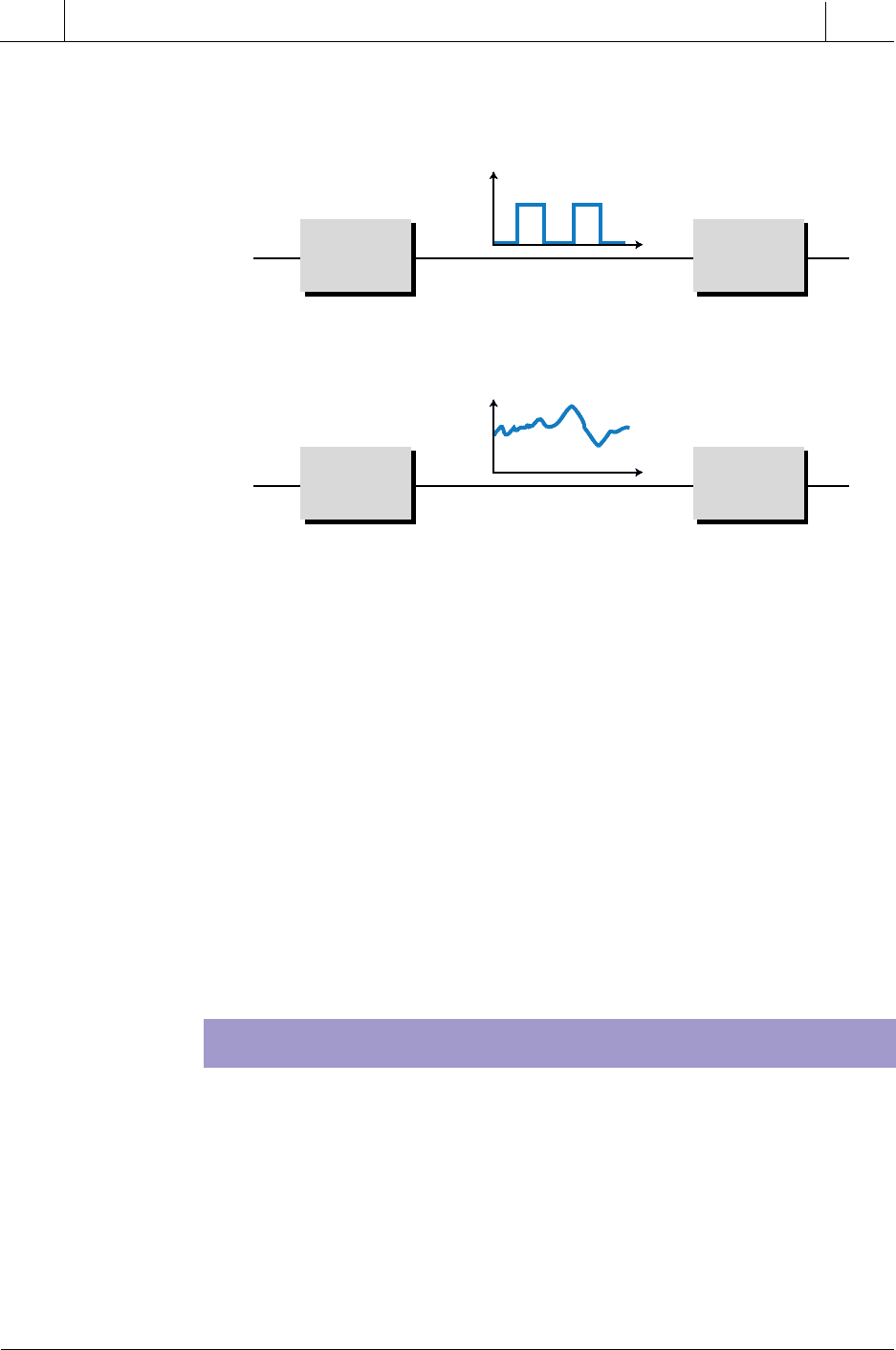
677
CHAPTER
15
Process Controllers
and Loop Tuning
SECTION
4
PLC Process
Applications
Industrial Text & Video Company 1-800-752-8398
www.industrialtext.com
signal (see Figure 15-10b). In this section, we will discuss discrete-mode
controllers. In the next section, we will explore continuous-mode controllers.
Figure 15-10. (a) Discrete- and (b) continuous-mode controllers.
Due to the nature of their signal, discrete-mode controllers produce a
conditionally stable response. This means that the system error fluctuates
between a predetermined deadband, creating a low-amplitude sinusoidal
response. These controllers are used in systems where this type of response
is acceptable. A noncritical heating system that uses an ON/OFF signal to
control the heater is an example of a discrete-mode controller. A home air-
conditioning and heating system is another example of a discrete-mode
system, because the process variable cycles between two values on either side
of the set point when the air conditioner or heater is turned ON or OFF. The
two most common types of discrete-mode controllers are:
• two-position controllers
• three-position controllers
TWO-POSITION DISCRETE CONTROLLERS
A two-position controller, also called an ON/OFF controller, is the most
basic type of process controller. As the name implies, it provides an ON/OFF
signal to the process’s control element (see Figure 15-11). A typical example
of an ON/OFF controller is a home heating system. The heater turns ON when
the temperature is below the set point and turns OFF when the temperature
reaches an acceptable level. Ideally, if the set point temperature is 70°F, the
heater will turn ON when the temperature is less than 70°F and turn OFF
when it is greater than 70°F, as the heater tries to keep the error (SP – PV) at
CV
Hc
(Controller)
OFF
ON
t
(a) Discrete controller
CV
PV
PV
Hp
(Process)
Hp
(Process)
t
(b) Continuous controller
Hc
(Controller)
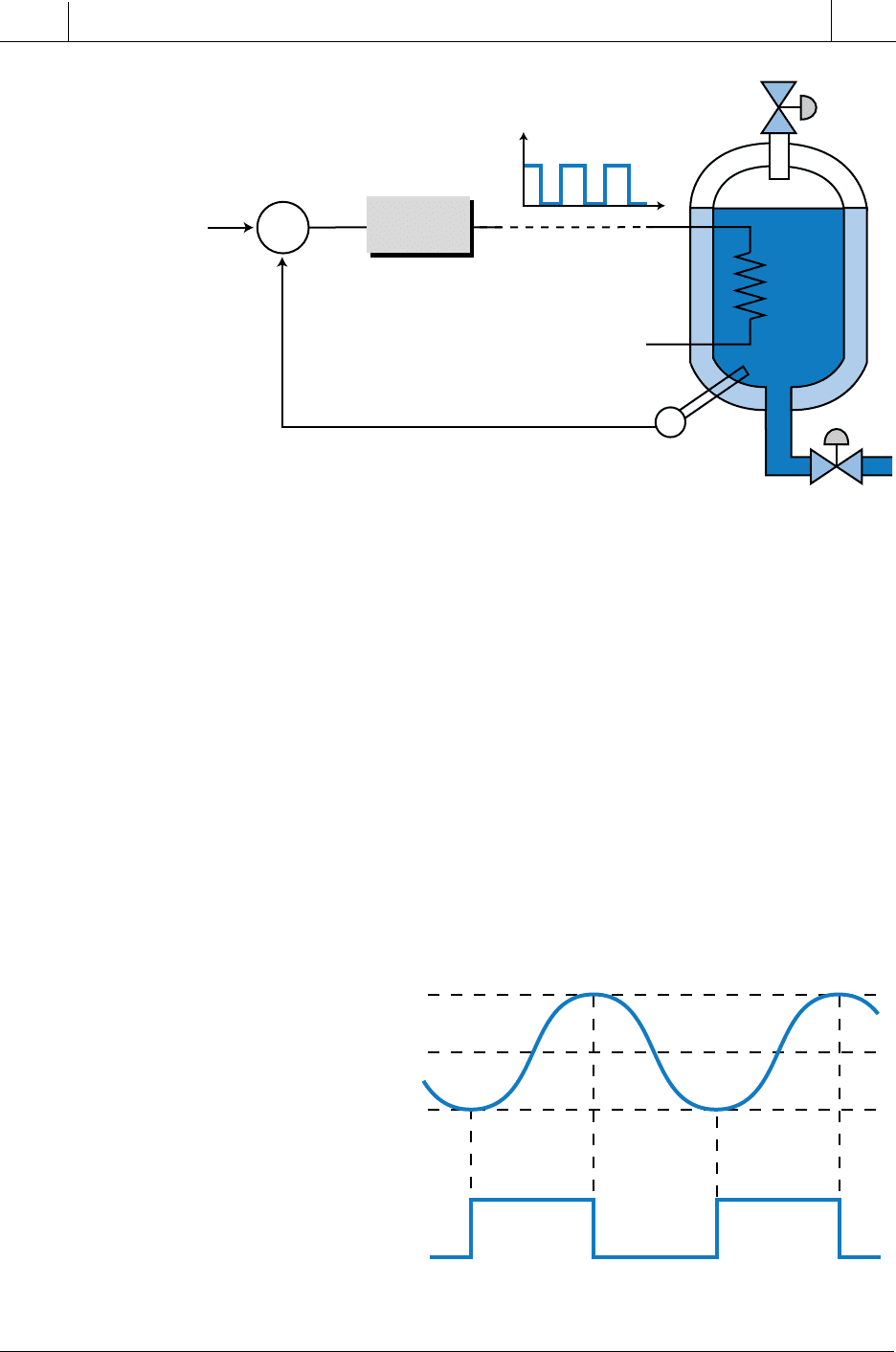
678
SECTION
4
PLC Process
Applications
Industrial Text & Video Company 1-800-752-8398
www.industrialtext.com
CHAPTER
15
Process Controllers
and Loop Tuning
Figure 15-11. Two-position discrete controller controlling a heater.
zero. However, most heating systems have an error deadband, meaning that
the heater will turn OFF at a value just above the target temperature and turn
ON at a value just below it. So, if the heater in our example has a deadband
of 68°F to 72°F, the heater will turn OFF when the temperature reaches 72°F
and turn ON when it falls to 68°F. This deadband range avoids the constant
ON/OFF action associated with trying to keep the process variable at one
exact set point.
The example heating system has a reverse-acting controller, because if the
controller senses that the process variable (temperature) decreases, it will
increase its output to 100% (ON), as shown in Figure 15-12. As a result of the
error deadband, the heater will turn ON when the temperature drops to 68°F
and turn OFF when it reaches 72°F. Furthermore, note that the controller is
sometimes ON and sometimes OFF within the error deadband. This depends
Figure 15-12. Behavior of the process and control variables in the heating system.
Hc
ESP
+
–
Σ
Temperature
Sensor
PV
Heater
(ON/OFF)
OFF
ON
72°
70°
68°
ON
OFF
Set Point
PV
CV
